Last Updated on February 15, 2025 by Mark S. Taylor
Scratches on car plastic are frustrating, but they don’t have to be permanent. Whether it’s your dashboard, door panels, or bumpers, knowing how to remove scratches from car plastic can help restore your car’s look. I’ve had my fair share of dealing with these marks, and the good news is, you don’t need expensive tools to fix them. With a few simple DIY tricks, you can make your car’s plastic look as good as new. Let’s get started!
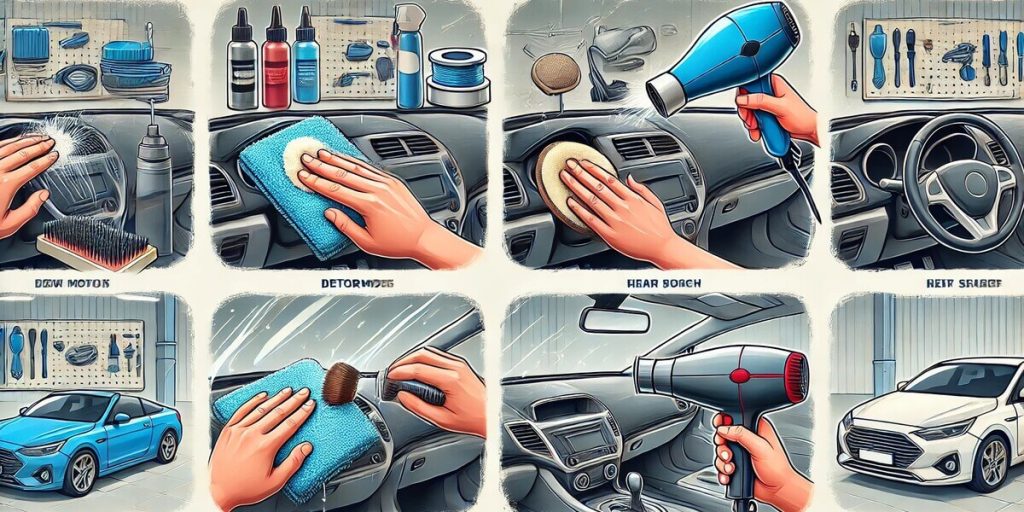
Contents
Understanding Car Plastic Scratches
Scratches on car plastic can be annoying, right? One minute your car looks flawless, and the next, there’s an ugly mark staring at you. I’ve been there—it’s frustrating! But not all scratches are the same. Some are just surface-level, while others go deep into the plastic. Let’s break it down so you know exactly what you’re dealing with.
Light vs. Moderate vs. Deep Scratches
- Light Scratches: These are the easiest to fix. If you run your fingernail over the scratch and don’t feel anything, it’s just a surface-level mark. Things like dust, improper cleaning, or even rubbing against your bag can cause these. A quick polish or a little heat can make them disappear.
- Moderate Scratches: These are a bit deeper. If your fingernail catches on the scratch, it has cut into the plastic but hasn’t gouged it. Common culprits? Keys, rings, or seatbelts rubbing against the surface. You might need a plastic polish or wet sanding to fix these.
- Deep Scratches: These are the worst. If you can see a white or lighter layer beneath the plastic, the scratch has gone all the way through. Deep scratches usually happen from sharp objects, rough handling, or accidents. Fixing these requires a plastic repair kit, filler, or even repainting.
What Causes Scratches on Car Plastic?
Plastic is durable, but it’s not scratch-proof. Everyday things can leave marks, including:
- Keys & Rings: Ever reached for something in your car and accidentally scraped your key across the dashboard? Yeah, that’s all it takes.
- Cleaning Mistakes: Using a rough cloth or scrubbing too hard can create tiny scratches over time. Always use a microfiber cloth!
- Seatbelt Friction: The constant rubbing of a seatbelt buckle against the plastic can leave behind ugly scuffs.
- Loading & Unloading: Throwing groceries, bags, or tools into your car without thinking? Guilty! Rough objects can easily scratch plastic panels.
Why Black Plastic Shows Scratches More
Ever noticed how black plastic surfaces—like dashboards and bumpers—make every little scratch stand out? That’s because of contrast. When a scratch cuts into the top layer, it exposes the lighter plastic underneath, making it look way worse than it actually is. This is especially common with textured plastics, which are harder to buff out compared to smooth ones.
The good news? Most scratches can be fixed. You don’t need expensive tools or a professional to do it. In the next section, I’ll walk you through the best DIY methods to remove scratches from car plastic—whether they’re light, moderate, or deep.
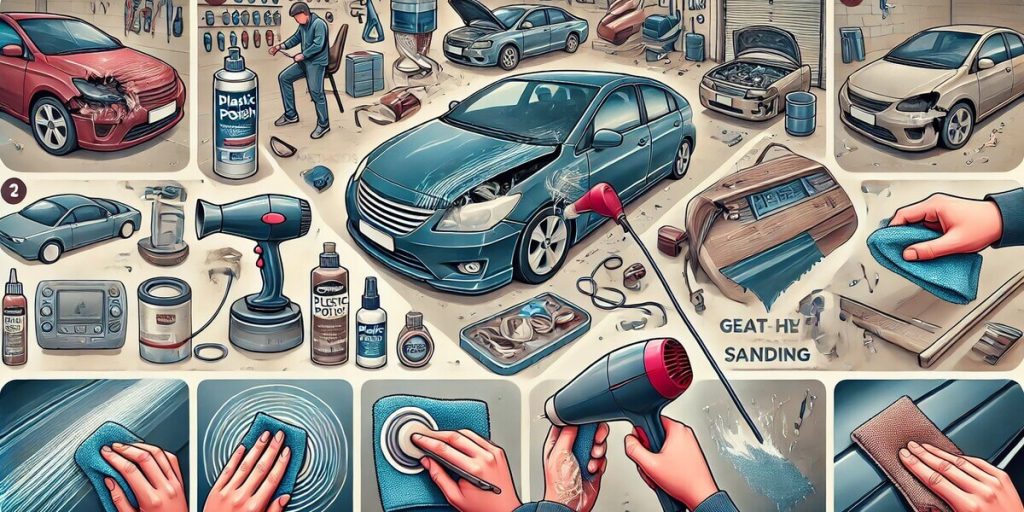
Best DIY Methods to Remove Scratches from Car Plastic
Scratches on car plastic can be a real eyesore, but the good news? Most of them can be fixed at home with a few simple tricks. I’ve tested these methods myself, and trust me, you don’t need fancy tools or expensive repairs. Whether it’s a light scuff on your dashboard or a deep scratch on your bumper, here’s how you can make your car’s plastic look brand new.
A. Removing Light Surface Scratches
These are the easy ones—the kind that make your car look dull but haven’t really damaged the plastic. You can fix them in minutes with things you probably already have at home.
👉 Use Heat to Buff Out Scratches
A little heat can do wonders for shallow scratches. I once used a hairdryer to remove scuffs from my car door panel, and it worked like magic. Just hold a hairdryer or heat gun a few inches away from the scratch and move it in circles. As the plastic warms up, it softens, and the scratch fades. Be careful not to overheat—it’s plastic, not a marshmallow!
👉 Try a Plastic Polish or Scratch Remover
If heat doesn’t work, a plastic polish or scratch remover can help. These products fill in tiny scratches and restore shine. I’ve had good results with brands like Meguiar’s PlastX and 3M Plastic Restorer. Just apply a small amount, buff in circles with a microfiber cloth, and watch the scratches disappear.
👉 Toothpaste or Baking Soda – The Budget Fix
No polish? No problem. Toothpaste or a baking soda paste (mix with a little water) can work as a mild abrasive. Apply it to the scratch, rub gently with a soft cloth, and wipe clean. It won’t fix deep scratches, but it’s a great hack for light scuffs.
B. Fixing Deeper Scratches in Plastic
Deep scratches take more effort, but they’re not impossible to fix. If you can feel the scratch with your fingernail, try one of these methods.
👉 Wet Sanding for Textured Plastics
For scratches on textured dashboards or trim, wet sanding is your best bet. I was nervous the first time I tried it, but it’s easier than it sounds. Start with 800-grit sandpaper (soaked in water) and gently sand the area in circular motions. Move up to 1500- or 2000-grit sandpaper to smooth it out, then finish with a plastic restorer. The result? A surface that looks brand new.
👉 Use a Plastic Repair Kit for Deep Scratches
If sanding isn’t enough, a plastic repair kit can fill in the scratch. These kits come with a filler compound that hardens like plastic, plus a texture pad to match your dashboard’s finish. It’s like putting a band-aid on your car—but one that actually works!
👉 Repainting or Dyeing the Plastic
For really bad scratches, the only way to get a perfect finish is to repaint or dye the plastic. I once had a deep gouge on my black bumper, and after trying everything else, I used a plastic trim restorer dye to blend the color. If the scratch is white or too noticeable, a spray paint designed for plastic (like SEM Trim Black) will give the best results.
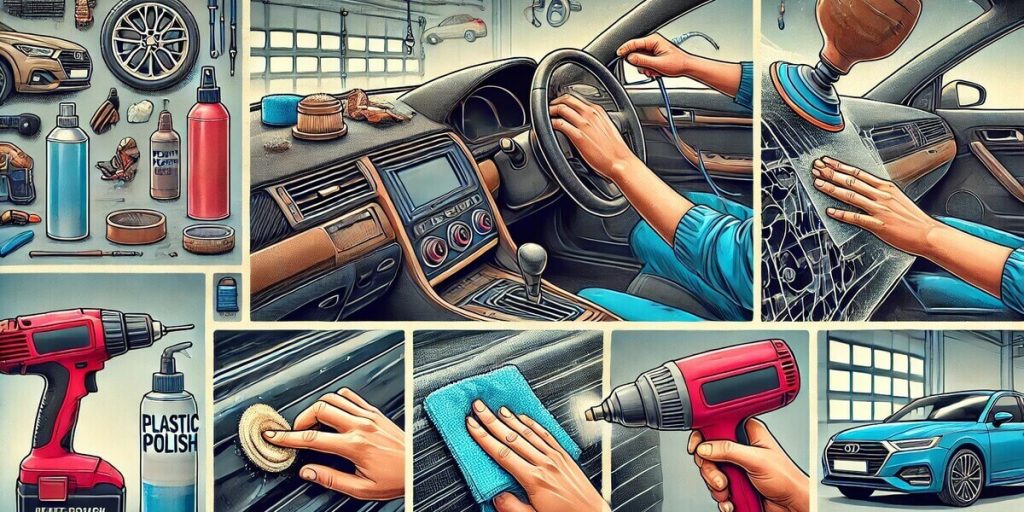
How to Remove Scratches from Specific Car Plastic Parts
Scratches don’t just show up in one spot—they can appear anywhere inside or outside your car. The dashboard, door panels, center console, and bumpers all have different types of plastic, which means they need different fixes. I’ve dealt with scratches in all these places, and trust me, knowing the right method can save you a lot of frustration. Let’s break it down!
Fixing Scratches on Interior Plastics (Dashboard, Door Panels, Center Console)
Your car’s interior takes a beating—keys, bags, rings, and even your own fingernails can leave marks. The good news? Most scratches here are shallow and easy to remove.
👉 For light scratches, a plastic polish or heat treatment (using a hairdryer or heat gun) works well. I once had an annoying scratch on my dashboard from my phone mount. A little heat softened the plastic, and with a gentle rub, the mark was gone.
👉 For deeper scratches, try wet sanding with fine-grit sandpaper (1500-2000 grit), followed by a plastic restorer. If the plastic is textured, use a plastic repair kit to blend the area. A friend of mine swears by trim restorer sprays, and after trying one myself, I can confirm—they work like a charm!
Removing Scratches from Black Plastic Bumpers
Black plastic bumpers show scratches more than any other part of your car. The contrast between the dark surface and the light-colored scratch makes even small scuffs look huge.
👉 For light scuffs, use a heat gun or plastic trim restorer. I once fixed a bumper scratch by simply heating it and rubbing it with a microfiber cloth. The plastic “healed” itself as the heat made it more flexible.
👉 For deeper scratches, wet sanding followed by a plastic dye or bumper repair kit is the way to go. If the scratch is really bad, a plastic-specific spray paint like SEM Trim Black can bring the bumper back to life.
Scratches on Textured vs. Smooth Plastic Surfaces
Textured plastic is tricky because you can’t just buff it out—you risk making the surface uneven.
- For textured plastic (dashboards, door panels): Use a repair kit that includes a texture pad to match the original finish. Sanding might remove the scratch, but it can also ruin the texture if not done carefully.
- For smooth plastic (center consoles, door trims): Polish, heat treatment, or sanding works well. Just be gentle to avoid adding new marks.
Scratches on car plastic are annoying, but they’re totally fixable with the right approach. Whether it’s your dashboard, bumper, or door panel, there’s a DIY solution that can make your car look like new again. Next, I’ll share the best products for removing scratches from car plastic—because having the right tools makes all the difference!
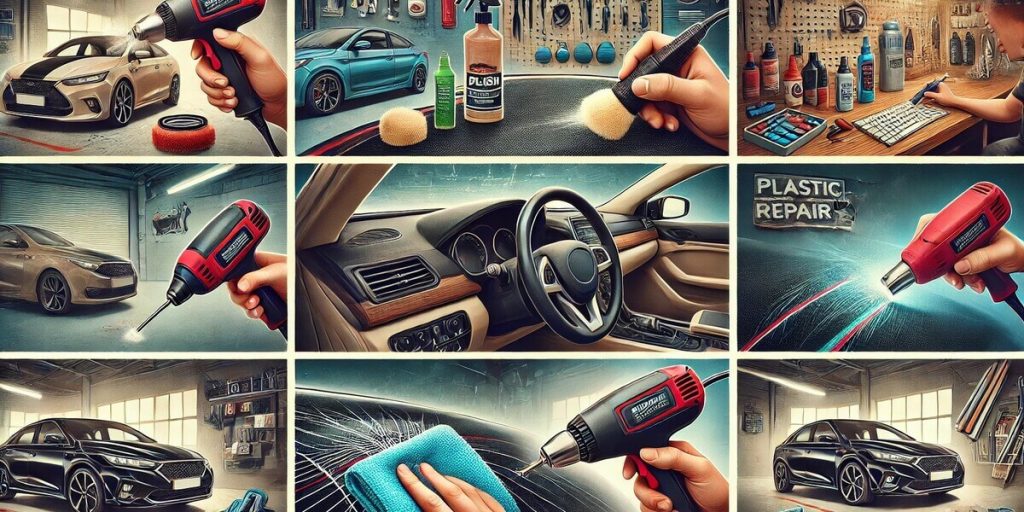
Best Products for Removing Scratches from Car Plastic
Let’s be real—scratches on car plastic are annoying. But the right product can make them disappear like they were never there. I’ve tried everything from DIY hacks to high-end scratch removers, and some work better than others. Whether you’re fixing your dashboard, door panels, or bumper, here are the best products to get the job done.
Best Car Interior Plastic Scratch Removers
If your dashboard, center console, or door panels have scratches, you need something gentle but effective.
👉 Meguiar’s PlastX – This is my go-to for light scratches and scuffs. It’s easy to use—just apply, buff, and wipe. I used it on my scratched center console, and it brought back the shine in minutes.
👉 3M Plastic Restorer – Works wonders on faded and scratched plastic. A buddy of mine used it on his car’s interior trim, and it looked brand new.
👉 Carfidant Scratch & Swirl Remover – If you want an all-in-one solution, this is solid. It works on both plastic and painted surfaces, making it a great multi-purpose option.
✅ Quick Tip: Always use a microfiber cloth to apply these products—anything rough can make the scratches worse!
Plastic Bumper Scratch Repair Kits – What Works Best?
Bumpers take the most damage, so you need something strong enough to fix deep scratches.
👉 Coconix Plastic Repair Kit – If your bumper has deep gouges, this kit is a lifesaver. It comes with a filler that blends into the plastic and restores the original texture.
👉 ATG Bumper Repair Kit – This one includes color-matching dyes, making it great for black plastic trim. I used it on my scratched bumper, and the results were impressive.
👉 Turtle Wax Trim Restorer – Not exactly a scratch remover, but it helps cover up minor scuffs and restores faded plastic. Perfect for keeping your bumper looking fresh.
✅ Pro Tip: For deep scratches, wet sanding before applying a repair kit will give the best results.
DIY vs. Professional Scratch Removal Solutions
So, should you fix scratches yourself or call a pro? It depends on the damage.
✔️ DIY Fixes Are Great For:
- Light scratches on dashboards, door panels, and center consoles.
- Surface-level scuffs on bumpers and trim.
- Budget-friendly solutions that don’t require a pro.
❌ Call a Pro If:
- The scratch is deep enough to expose a different layer of plastic.
- The damage is too large for a repair kit to handle.
- You want a flawless, factory-like finish.
Most scratches can be fixed with the right DIY product, but for serious damage, a professional repair might be worth the investment.
The right scratch remover can make all the difference. Whether you go with a simple polish, a repair kit, or a full-on restoration, you’ll be amazed at how much better your car’s plastic can look. Next up, let’s talk how to prevent future scratches—because avoiding them is even better than fixing them!
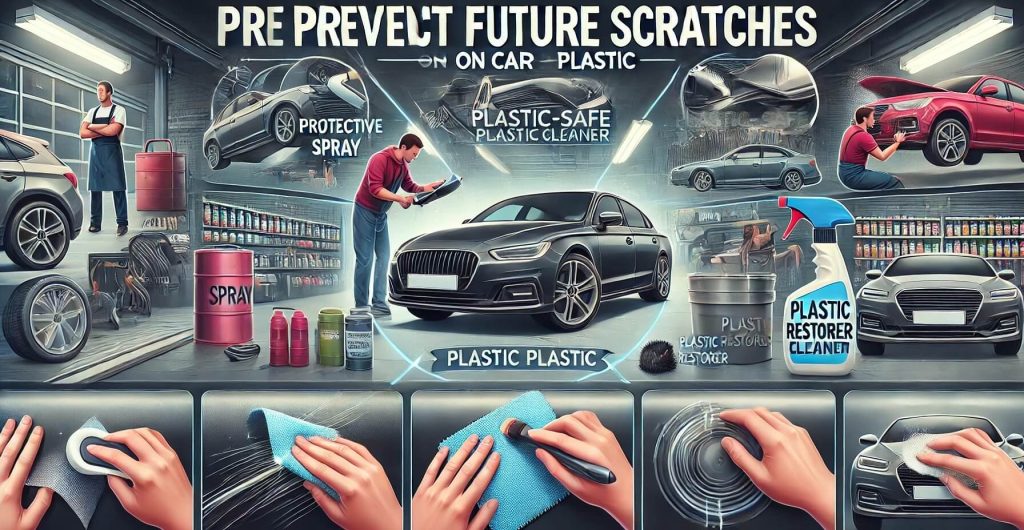
Preventing Future Scratches on Car Plastic
Fixing scratches is great, but avoiding them is even better. I’ve learned this the hard way! A little care can keep your car’s plastic looking new. Let’s go over the best ways to protect it.
Use Protective Sprays and Coatings
A good plastic protectant can stop scratches before they happen. It adds a thin layer that repels dust, dirt, and UV rays.
👉 303 Aerospace Protectant – My go-to! It keeps plastic smooth and dust-free without feeling greasy.
👉 Meguiar’s Ultimate Black – Perfect for black plastic. It restores color and prevents fading.
👉 Turtle Wax Trim Coating – Best for bumpers and trim. It adds a tough, water-resistant layer.
✅ Tip: Apply every few weeks to keep plastic looking fresh.
Best Cleaning Methods to Avoid Scratches
A bad cleaning routine can do more harm than good. I used to wipe my dashboard with a dry cloth—big mistake! Here’s what works best:
✔️ Use a microfiber cloth – It traps dust without scratching.
✔️ Avoid dry wiping – Always use a plastic-safe cleaner or a damp cloth.
✔️ Be gentle – Rubbing too hard can leave fine marks.
✅ Tip: Use compressed air for vents and textured surfaces. It cleans without contact!
How to Restore Faded or Scratched Plastic
Plastic fades over time, especially black trim. Here’s how to bring it back:
👉 Plastic restorer sprays – CarGuys Plastic Restorer and Gtechniq C4 bring back color and shine.
👉 Heat treatment – A heat gun can revive black plastic. Just be careful—too much heat can warp it!
👉 Trim dyes and paints – For heavy fading, SEM Trim Black works wonders.
✅ Tip: Use a plastic conditioner regularly to slow down fading.
What’s the best way to remove scratches from black plastic car interiors?
Use a plastic polish like Meguiar’s PlastX or 3M Plastic Restorer. For deeper scratches, try wet sanding with 1500-grit sandpaper and apply a trim restorer for a smooth finish.
Can toothpaste remove scratches from car plastic?
Yes, but only for light scratches. Toothpaste acts as a mild abrasive to buff out surface marks. Apply a small amount, rub in circles with a microfiber cloth, then wipe clean.
How do you fix deep scratches on a plastic dashboard?
For deep scratches, use a plastic repair kit with a filler compound. Sand the area smooth, apply the filler, and use a texture pad to match the original surface.
Is heat good for removing plastic scratches?
Yes, for shallow scratches. A hairdryer or heat gun softens the plastic, helping scratches fade. Use light heat and buff with a microfiber cloth to blend the surface.
What’s the best scratch remover for plastic trim?
CarGuys Plastic Restorer and Turtle Wax Trim Coating are top choices. They fill in minor scratches, restore color, and add a protective layer to prevent future damage.
My Final Thoughts on Removing Scratches from Car Plastic
If you love keeping your car looking fresh, DIY scratch removal is a game-changer. With the right tools—like plastic polish, heat, or a repair kit—you can fix most scratches at home. But if the damage is deep, a pro might be the better choice for a flawless finish.
I’ve tried both DIY and professional fixes, and honestly, simple scratches don’t need a shop visit. A little polish and patience can go a long way! But for deep gouges or fading, a trim restorer or repainting is worth it.
At the end of the day, it’s all about what works best for your car and budget. Whether you go the DIY route or call in the experts, the good news is—scratches don’t have to be permanent!
